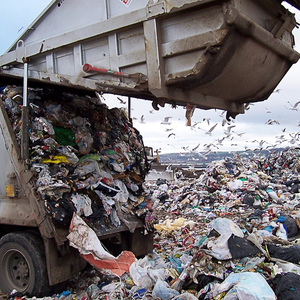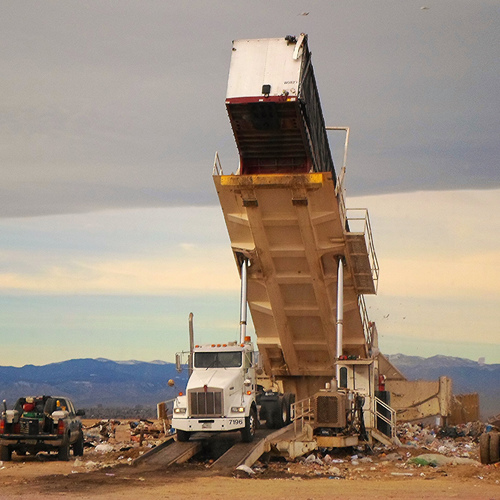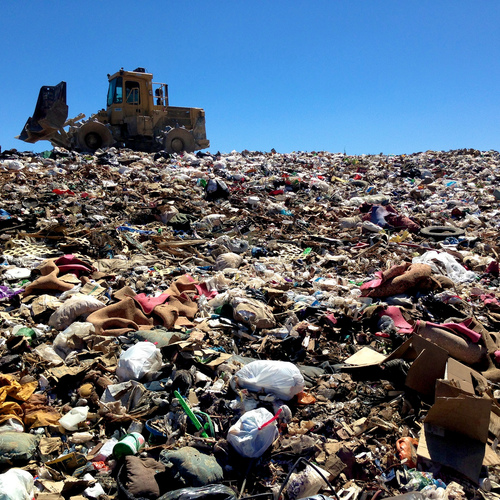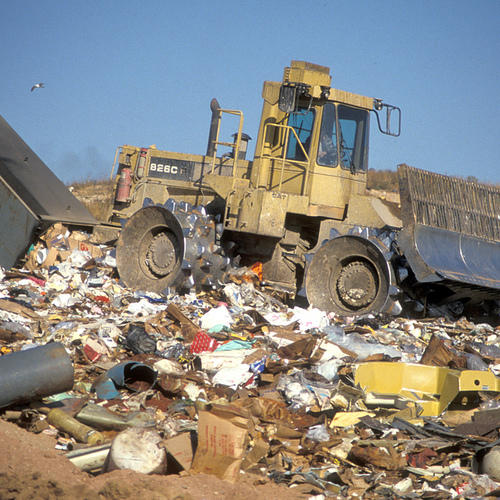Image Credit: Anthony-Masterson/Getty Images
Image Credit: Anthony-Masterson/Getty Images If your only two options are landfilling food waste, or putting it down the drain in a disposal, disposals come out better in a new study.
Image Credit: Insinkerator
I have been having a lot of fun feeding worms my garbage. We have something you could either call a “worm bin” or a “home vermicomposting system,” and we throw our food scraps, banana peels, melon rinds, moldy bread — you name it — into that. There are a couple pounds of worms in the bin, and they gratefully accept the waste, eat it, and turn it into worm castings, which is basically organic matter that is broken down in such a way that it’s very good for our garden.
Here’s how it works. I started with two pounds of redworms, purchased from Green Mountain Soil. I set up a plastic bin with a few buckets of partially rotted horse manure. This serves as the worm “bedding.” Whenever our compost crock is full, I take it into the basement, dig a hole in the bedding, empty the crock, and cover it with a bit of bedding. Within a couple weeks, it’s gone.
For more information, the classic how-to book on the topic is “Worms Eat My Garbage” by the “worm woman,” Mary Appelhof.
Since we started a more serious vegetable garden this year, I’ve been a bit obsessed with building our soil, and I wasn’t happy with how things we put on our compost pile basically sat and rotted, while attracting pests. And in winter, it just builds up on the snow. Using worms to turn those food scraps into more valuable compost in a matter of weeks seemed like a good idea.
What I didn’t count on was the fun of having worms as pets. I just love seeing the little guys squirm around, multiply, and make carrot peelings disappear.
Forty percent of food in U.S. wasted
I also didn’t know that composting food was so environmentally friendly, but a new study shows that it truly is.
Forty percent of the food produced in the U.S. is wasted; that’s about 1,400 calories per person per day, according to the magazine Next Generation Food. Although some of that waste occurs during processing and at stores, and some of it is also due to how we cook (tossing potato peels, for example), it’s undeniable that we waste a huge quantity of food.
Most of this trashed food goes straight to landfills, where it releases huge quantities of methane, a potent greenhouse gas, into the atmosphere. A new study looks at several ways in which food waste is processed, and identifies environmentally preferable options.
New environmental analysis bankrolled by food disposal maker
The analysis, commissioned by the manufacturer of InSinkErator food disposal systems and performed by independent research group PE International, looked at 12 common ways that municipalities deal with food waste and compared their environmental impacts, including global warming potential (GWP), energy use, and likely effects on soil, water, and air quality.
The study takes into account the cradle-to-grave life cycle of associated equipment (trash cans and bags, garbage disposals, etc.) but does not appear to consider water use — an apparent oversight, considering that garbage disposals require running water before, during, and after use.
Composting and waste-to-energy are winners
Although several water-treatment options require more energy than landfills, garbage disposals come out looking quite good compared with landfills in terms of GWP and direct effects on soil, water, and air quality. Even the most energy-intensive methods of wastewater treatment weigh in at half the GWP of landfilling.
However, composting — not the backyard scrap pile, but centrally located “advanced” composting — and waste-to-energy had minuscule energy and GWP impacts compared with most wastewater treatment options. Composting is not without issues, however, including the second-highest smog potential among the 12 methods considered.
Food disposals better than landfill
Based on this study’s findings, a garbage disposal is not necessarily the most environmentally friendly way to deal with wasted food, even as InSinkErator often argues for its benefits. However, the study indicates that if your only two options are the trash can or a garbage disposal, the garbage disposal is a safer bet in terms of greenhouse gases and most other environmental impacts, despite its greater energy use.
Fortunately, a growing number of people have more choices than landfill or garbage disposal. For example, folks in our municipality can compost in the backyard, or if that’s not your cup of tea, you could consider dropping your waste, including paper food containers and other items for “advanced composting,” with the solid waste management district.
My favorite option, though, is definitely letting worms eat my garbage. I just love watching those little worms canoodle.
Tristan Roberts is Editorial Director at BuildingGreen, Inc., in Brattleboro, Vermont, which publishes information on green building solutions.
Weekly Newsletter
Get building science and energy efficiency advice, plus special offers, in your inbox.
















3 Comments
Another benefit to composting...
...is that if you set aside biodegradable items for the compost bin, then there's nothing too messy left in the garbage. After a combination of careful shopping (to avoid needless packaging), recycling and composting, there's not much left in the garbage and it can take a long time to fill a bag. But it doesn't get gross when there's nothing left to decay, just certain types of non-recyclable packaging.
Soldier Fly Larvae
We throw everything into an outdoor compost bin that is filled with soldier fly larvae. They eat everything almost overnight. A huge pile of even heavy stuff—like watermelon rinds—somehow gets redistributed across the surface by the bugs. No need to cover it with a dry carbon mix either—they keep away flies, fruit flies, and even (usually) smells.
The only downside is that they don't overwinter here.
That is so cool. I never
That is so cool. I never thought about using worms as a natural means of decomposition. Makes a lot of sense though. Seems like a viable option but for the fact that I'm sure that would likely turn a few stomachs. I've been sticking with the garbage disposal myself.
Log in or create an account to post a comment.
Sign up Log in